Oklahoma is in the Southwest region of the United States. This state is home to over 4 million people and large cities with strong economies serving as economic hubs. Keep reading to discover the largest cities in Oklahoma, ranked by population, total area, and economic impact.
Largest Cities in Oklahoma by Population
Oklahoma is the 28th state by population and features some large cities.
| Rank | City | Population (2022 Estimate) |
|---|---|---|
| 1 | Oklahoma City | 694,800 |
| 2 | Tulsa | 411,867 |
| 3 | Norman | 129,627 |
| 4 | Broken Arrow | 117,911 |
Oklahoma City

OKC is the 74th largest city by population in the country.
©Sean Pavone/Shutterstock.com
Oklahoma City, also called OKC, is the state capital and the largest city by population. OKC is located in the central part of Oklahoma, within the Great Plains region of the United States.
As of the 2022 estimate, Oklahoma City has a population of approximately 694,800. The city’s population has largely grown, fueled by a strong economy. Between 2010 and 2020, Oklahoma City’s population increased by 17.4%.
Thanks to its vast total area, the city also has a relatively low population density compared to major U.S. Cities. With 1,122.96/sq mi, this density gives residents plenty of space throughout the city with more spacious suburbs and neighborhoods.
The city has seen significant economic growth and development, especially in energy, healthcare, aerospace, and technology sectors. This attracts professionals and job seekers from various parts of the country.
The age population is diverse, with a mix of young professionals, families, and retirees. Thanks to several universities and colleges, thousands of students also live in OKC.
Tulsa
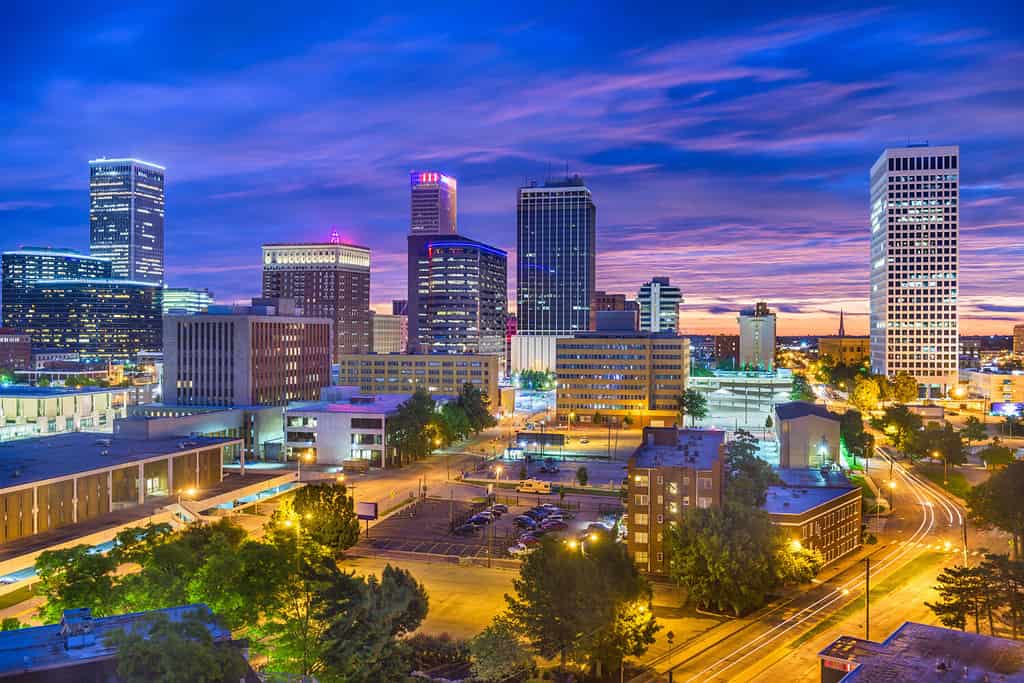
Each year, at the end of September and the start of October, over a million visitors come to the Tulsa State Fair.
©Sean Pavone/Shutterstock.com
Located in the northeastern part of Oklahoma, Tulsa is the second-largest city in the state. The city is also close to Kansas’ border.
According to the 2022 estimate, Tulsa had a population of approximately 411,867 people. Tulsa has a population growth less significant than Oklahoma City, but it still increased by 5.4% between 2010 and 2020. The city has a large land area, which results in a population density of 1,356.58/sq mi, contributing to a good quality of life.
Tulsa covers a large area, which results in a moderate density of 2,088.67/sq mi. This contributes to more spaces in suburban parts of the city.
The city of Tulsa is known for its cultural diversity. The city has a mix of racial and ethnic backgrounds, with a substantial African-American, Caucasian, Hispanic, and Native American population. Tulsa’s diversity is reflected in its various cultural events, festivals, and dining options.
In recent years, Tulsa has diversified its economy from energy to aerospace and healthcare. This brought new professionals and skilled workers to the city. Adding to the mix are thousands of students from the University of Tulsa and Oral Roberts University. The student population contributes to a younger and more vibrant population.
Norman
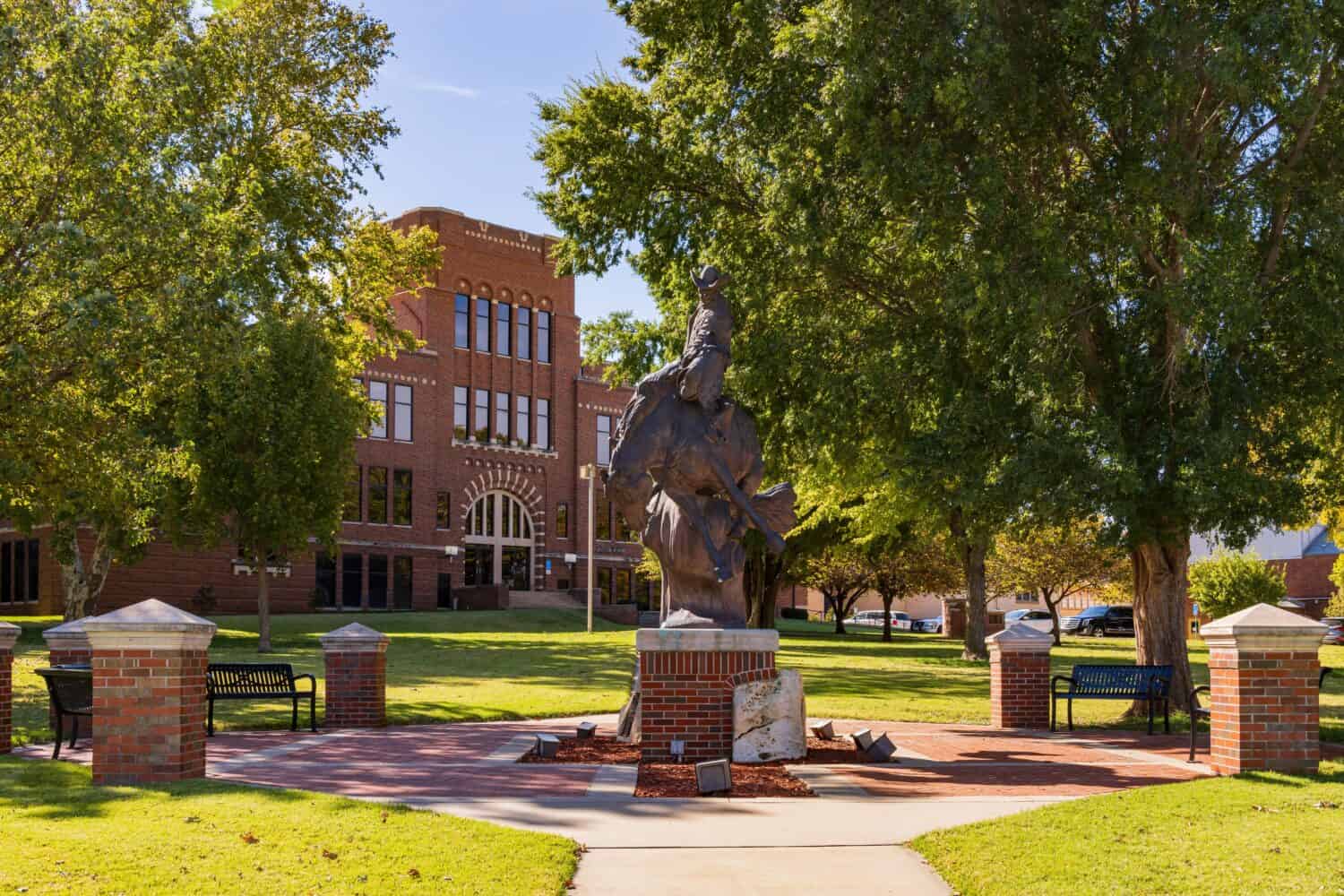
The University of Oklahoma (OU) was established 17 years before Oklahoma’s statehood.
©Kit Leong/Shutterstock.com
Norman is in central Oklahoma, approximately 20 miles south of the state capital, Oklahoma City. Known for its vibrant culture, academic institutions, and strong community spirit, Norman also holds a rich history.
As of the 2022 estimate, Norman has a population of 129,627 residents, making it the third-largest city by population in Oklahoma. Norman’s population is also highly increasing, similar to Oklahoma City, with a change percentage of 15.4% between 2010 and 2020.
One advantage of Norman is its extremely low density for a city this populated. With 716.64/sq mi, Norman offers plenty of space to its inhabitants in every neighborhood around the city.
With its economic diversity, Norman attracts families, young professionals, and skilled workers. However, an essential demographic in the city is its student population. Norman is home to the University of Oklahoma (OU), a prestigious institution. In the fall, the University of Oklahoma welcomed more than 30,000 undergraduates and graduates. This significantly impacts the city’s demographics, as OU’s student population approximately makes up 23% of Norman’s population.
Broken Arrow
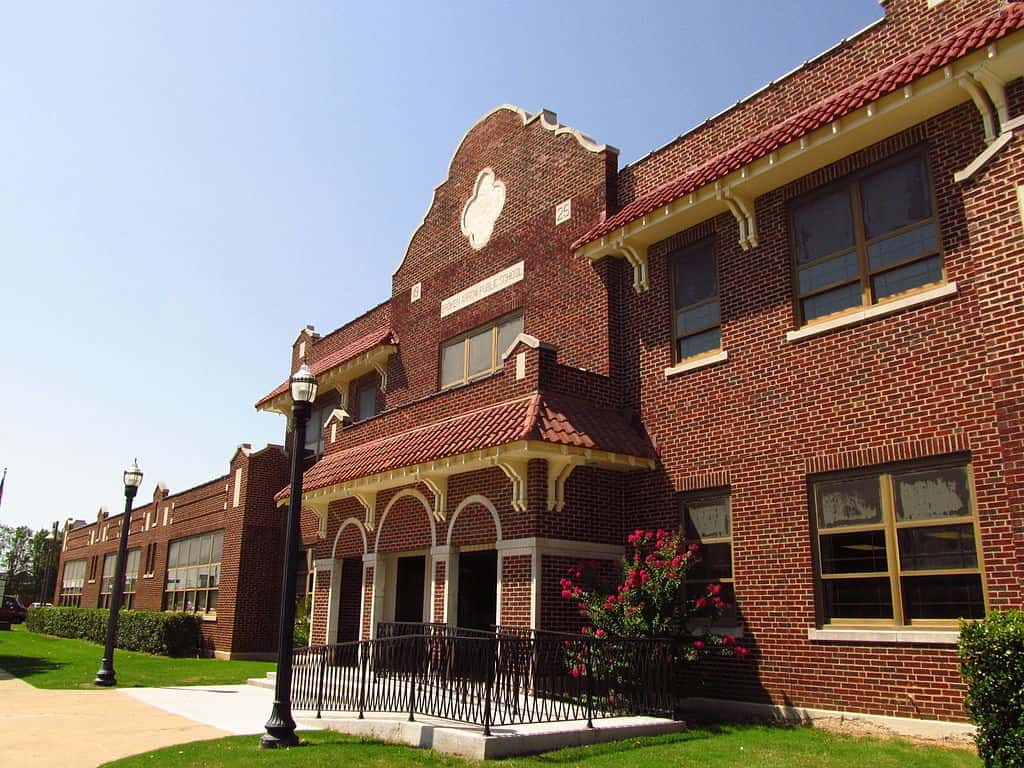
The city started to grow from a town to a suburban city in the 60s.
Broken Arrow is a prominent city located in northeastern Oklahoma, near Tulsa. The city is known for its dynamic community, economic growth, and family-friendly atmosphere.
The city has a population of 117,911, according to the 2022 estimate. Broken Arrow boasts a high growth rate, with a 14.9 increase between 2010 and 2020.
Like the preceding large cities, Broken Arrow has a moderate density of 1,803.34/sq mi, giving ample space to its residents in the different neighborhoods.
Broken Arrow’s demographics have become increasingly diverse. While the city has traditionally had a predominantly white population, there has been a rise in residents from various ethnic backgrounds. This diversity has enriched the city’s culture and led to a more inclusive community.
The city is home to a diverse population of students, young professionals, families, and retirees.
Largest Cities in Oklahoma by Total Area
Oklahoma ranks as the 20th biggest state in the country.
| Rank | City | Total Area (Square Miles) |
|---|---|---|
| 1 | Oklahoma City | 621 |
| 2 | Tulsa | 201.9 |
| 3 | Norman | 189.2 |
Oklahoma City
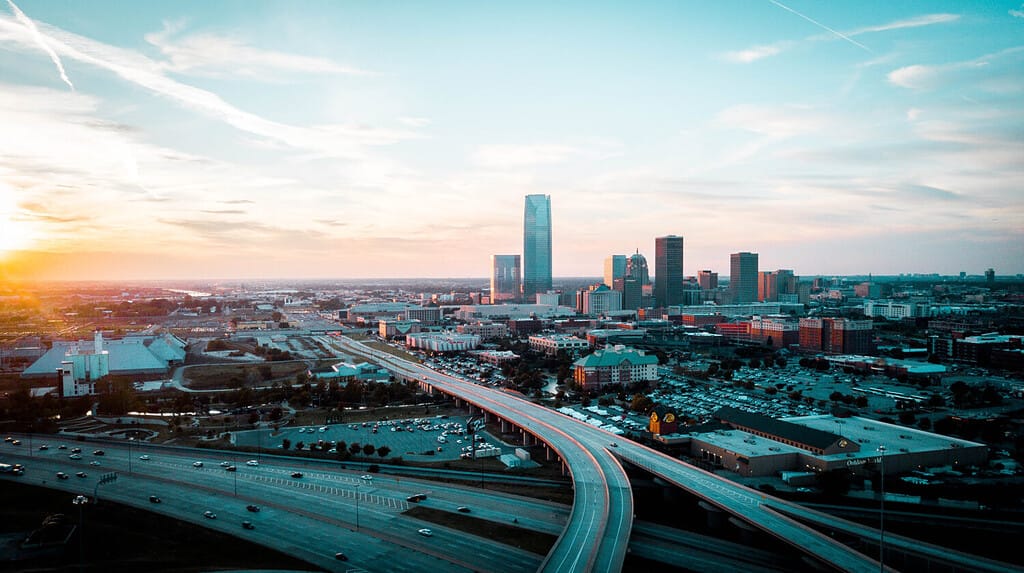
With its 621 square miles of total area, OKC is the fourth-largest city in the country.
©Gerson Repreza/Shutterstock.com
Oklahoma City, the largest city by population, is also Oklahoma’s largest city by total area, with 621 square miles (1,608.4 square kilometers). The city’s landscape is characterized by gently rolling terrain, with the North Canadian River flowing through the northern part of the city. OKC is also a vibrant and rapidly growing metropolis with a rich history and diverse culture.
Oklahoma City experiences a humid subtropical climate. Summers are hot, and temperatures can exceed 90°F (32°C) in June, the hottest month. Winters are generally mild, with average lows in the 30s and 40s °F (around 4-9°C). Snowfall is rare but possible. Spring and fall are the most pleasant seasons, with comfortable temperatures and lower humidity.
The city is prone to severe weather, including thunderstorms, tornadoes, and hail storms, especially during the spring and early summer. Residents are accustomed to being prepared for extreme weather events.
Natural Attractions
While Oklahoma City is primarily known for its urban amenities and cultural attractions, it also offers several natural attractions for residents and visitors.
- Myriad Botanical Gardens: In the heart of downtown, the Myriad Botanical Gardens is a beautiful oasis featuring lush gardens, walking paths, a tropical conservatory, and a picturesque lake. It’s a tranquil escape from the urban hustle and bustle.
- Lake Hefner: This reservoir in northwest Oklahoma City offers recreational activities such as boating, fishing, and picnicking. The lake has parks, jogging trails, and restaurants with scenic views.
- Oklahoma City Zoo: The zoo is home to a wide variety of animals worldwide and provides an excellent opportunity for wildlife enthusiasts to observe and learn about various species.
- Red Rock Canyon Adventure Park: West of the city, this park offers hiking, rock climbing, and rappelling opportunities amid stunning red rock formations. It’s a popular spot for outdoor adventurers.
- Oklahoma River: The river is now a vibrant waterway with recreational activities like kayaking, rowing, and cycling along its scenic riverwalk.
- Martin Park Nature Center: This nature preserve in northwest Oklahoma City offers hiking trails, educational programs, and a chance to explore the local flora and fauna.
Oklahoma City also boasts a thriving arts and cultural scene, numerous museums, and a great food scene. Sports fans? The NBA team, Oklahoma City Thunder, can always welcome new fans!
Tulsa
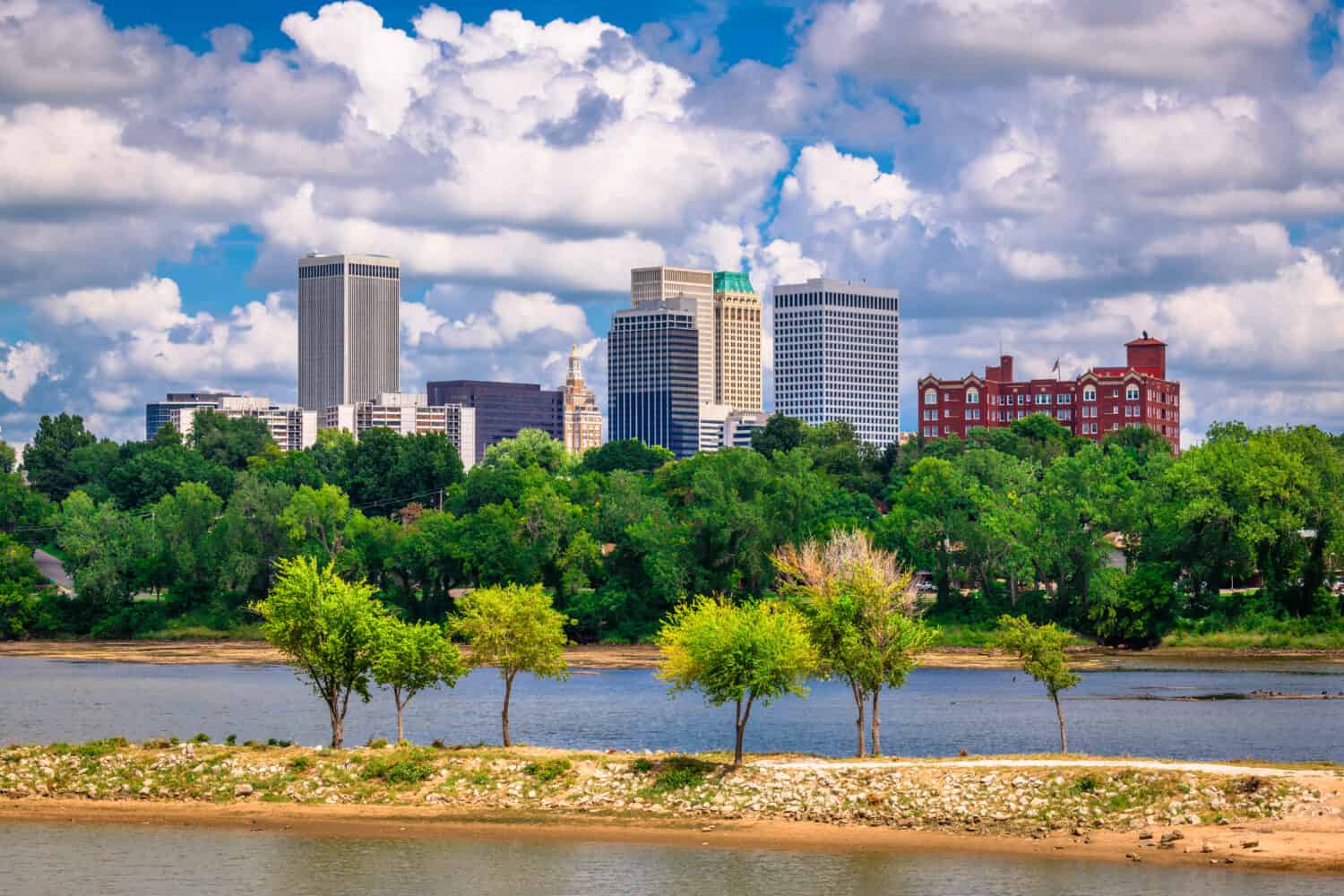
With its proximity to the Arkansas River, Tulsa offers plenty of recreational opportunities.
©Sean Pavone/Shutterstock.com
With 201.9 square miles (522.9 square kilometers), Tulsa is Oklahoma’s second-largest city by total area. Nestled within the region known as “Green Country” due to its lush, rolling hills and verdant landscape, the city is also located along the Arkansas River. Tulsa is famous for its unique blend of urban amenities, natural beauty, and rich history.
Tulsa experiences a humid subtropical climate with four distinct seasons. Summers in Tulsa are hot and humid, with temperatures often reaching into the 90s°F (32-37°C). Fall brings cooler temperatures, with stunning foliage taking on vibrant red, orange, and gold hues. Winters are relatively mild, with temperatures typically ranging from the 30s°F to 50s°F (1-15°C). While snowfall is infrequent, occasional ice storms can occur. Spring has moderate temperatures and blooming vegetation. It’s an ideal time to enjoy the city’s parks and gardens.
Natural Attractions
Tulsa is famous for its culture and history but also offers great natural attractions.
- Gathering Place: This sprawling riverside park offers various recreational activities, including playgrounds, gardens, trails, and a man-made lake.
- Turkey Mountain Urban Wilderness Area: Within the city limits, Turkey Mountain offers hiking and biking trails with picturesque views of the Arkansas River and the surrounding landscape.
- Oxley Nature Center: This 800-acre nature center within Mohawk Park provides educational opportunities and nature exploration, featuring hiking trails, wildlife viewing, and a visitor center.
- Redbud Valley Nature Preserve: Located just outside Tulsa, this nature preserve offers hiking trails through a scenic wooded area with springtime redbud blooms.
- Tulsa Botanic Garden: A serene oasis featuring themed gardens, walking trails, and stunning seasonal displays, the Tulsa Botanic Garden is a great place to connect with nature.
Tulsa is renowned for its vibrant arts and culture scene, with numerous museums, galleries, theaters, and music venues. The city’s rich history, especially its ties to the oil industry, is also prominently featured in various museums and historic sites.
Norman

Lake Thunderbird is a favorite of Norman residents.
©JohnDSmith/Shutterstock.com
As the third-largest city by population, it is also in the third position for the total area with 189.2 square miles (490 square kilometers). The city is part of Cleveland County and is characterized by its gently rolling terrain. The Canadian River flows to the south of the city, providing outdoor recreational opportunities and scenic views.
Norman experiences a humid subtropical climate, typical of much of Oklahoma. Summers in Norman are hot and humid, with average high temperatures often exceeding 90°F (32°C). Thunderstorms are common in the summer, providing much-needed relief from the heat. Winters are relatively mild compared to many parts of the United States. Average low temperatures in the winter months typically stay above freezing. There are occasional cold snaps and even some snowfall.
Tornadoes are a concern in this region, particularly in the spring and early summer, as Oklahoma is part of Tornado Alley.
Natural Attractions
Norman offers several notable natural attractions and outdoor activities.
- Lake Thunderbird State Park: Located east of Norman, Lake Thunderbird State Park is a popular destination for boating, fishing, hiking, and camping. The park features two marinas and offers opportunities for birdwatching and wildlife observation.
- Sutton Wilderness: This urban wilderness area within Norman provides hiking trails and a natural escape for residents and visitors.
- George M. Sutton Urban Wilderness Area: Located within Norman, this area offers hiking and biking trails through wooded terrain and along the banks of the Canadian River.
Norman’s combination of cultural offerings, educational institutions, and access to natural beauty makes it a well-rounded and appealing city for both residents and visitors.
Largest Cities in Oklahoma by Economic Impact
| Rank | City | Gross Domestic Product (GDP) in 2021 |
|---|---|---|
| 1 | Oklahoma City | 86,662 million |
| 2 | Tulsa | 60,392 million |
Oklahoma City
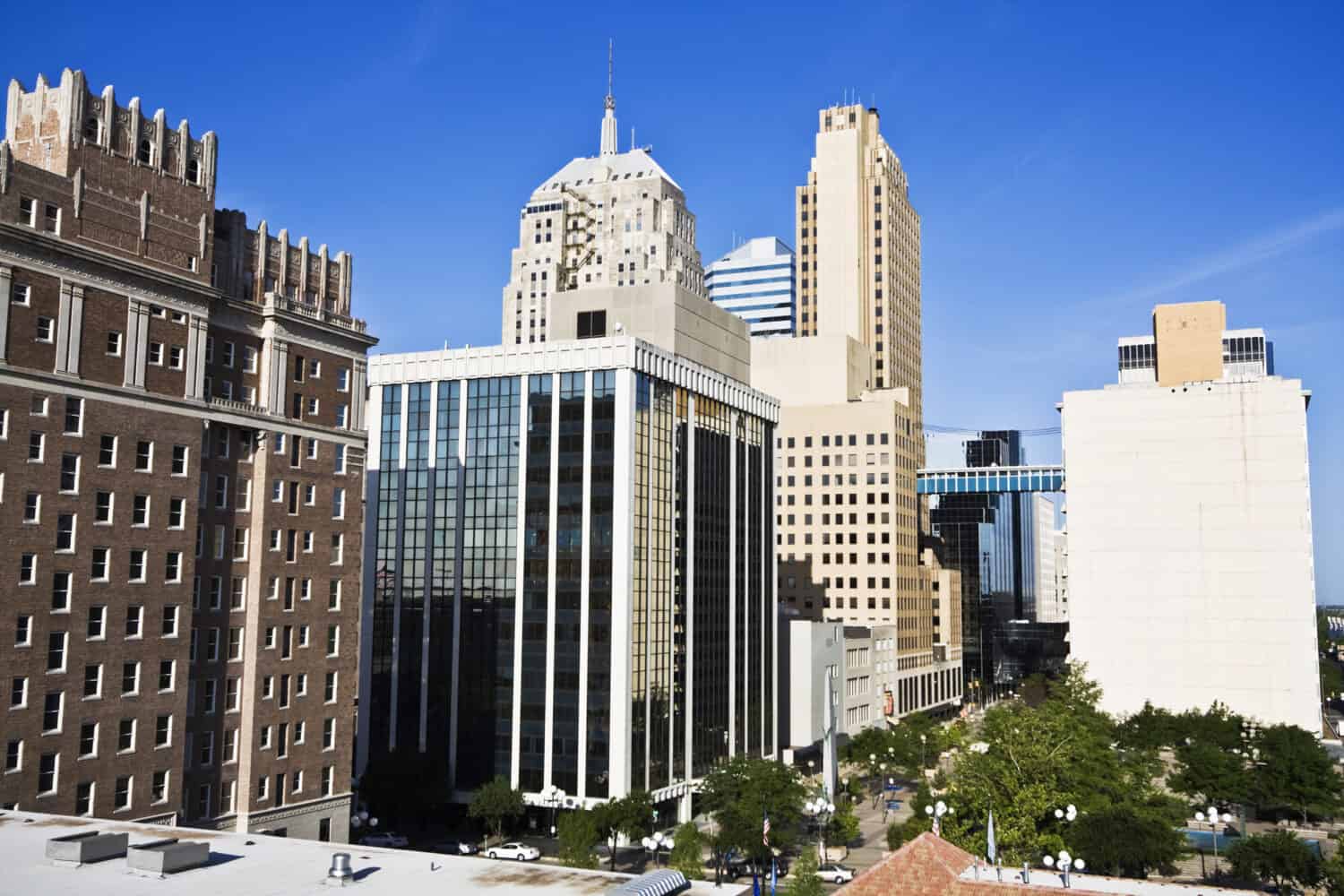
Aviation and aerospace are the largest sectors by employment and economic impact in Oklahoma City.
©Henryk Sadura/Shutterstock.com
Oklahoma City has a strong, dynamic, and diverse economy. These are the city’s key sectors and employers.
Aerospace and Defense
Tinker Air Force Base, one of the largest military installations in the United States, plays a significant role in the city’s economy. The base employs thousands of civilians and military personnel and plays a crucial role in aircraft maintenance, repair, and logistics.
In addition to the military, more than 300 public and private aviation and aerospace companies are now located in Greater OKC.
Energy
Oklahoma City has a strong presence in the energy industry, with a particular focus on oil and natural gas. It is home to many energy companies, including Devon Energy, Chesapeake Energy, and Continental Resources. The city’s strategic location in the energy-rich Anadarko Basin has contributed to its prominence in this sector.
Devon Energy, for example, is one of the largest independent oil and natural gas exploration and production companies in the United States. With its headquarters in Oklahoma City, it is one of OKC’s largest employers.
Continental Resources is also headquartered in Oklahoma City and provides numerous jobs.
Healthcare
The healthcare industry is a growing sector in Oklahoma City, with major institutions like the University of Oklahoma Health Sciences Center and Integris Health contributing to the city’s reputation as a regional healthcare hub. It is a significant employer in OKC.
Technology and Innovation
Oklahoma City is striving to become a hub for technology and innovation. The Oklahoma City Innovation District, which includes organizations like the Oklahoma Medical Research Foundation and the Oklahoma Health Center Foundation, fosters collaboration in biotechnology, medical research, and entrepreneurship.
Tulsa
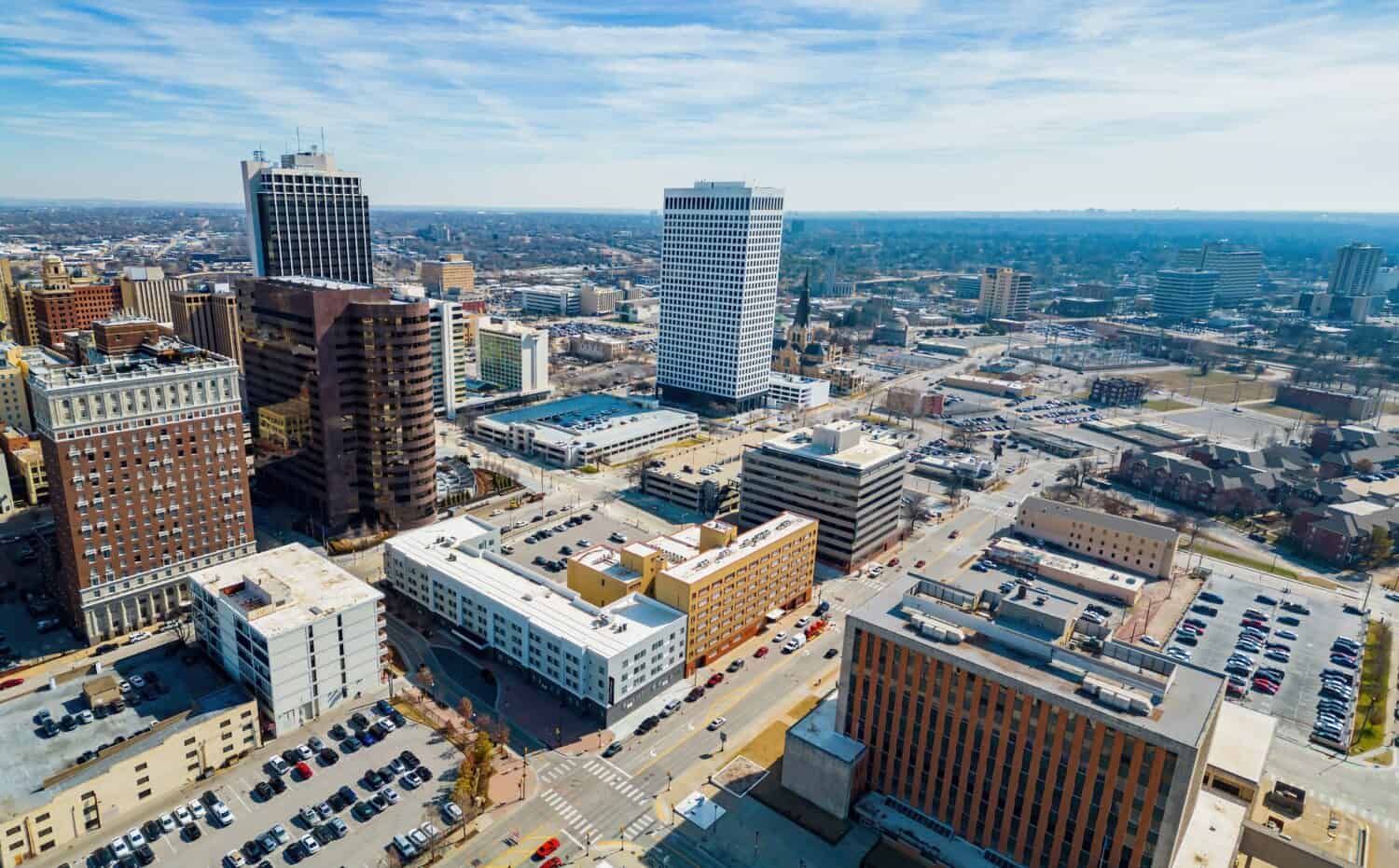
After building its economy on oil and gas, Tulsa is diversifying towards other sectors.
©Kit Leong/Shutterstock.com
Often called the “Oil Capital of the World,” Tulsa has a significant historical significance in the oil industry. These are Tulsa’s key sectors and employers.
Energy
Tulsa’s ties to the energy sector run deep. The city’s economy was initially built on oil and natural gas production. It remains a hub for energy companies, including exploration, production, and services.
Williams Companies and ONE Gas have their headquarters in Tulsa and are some of the largest employers in the city.
Aerospace and Aviation
Tulsa has a thriving aerospace and aviation industry, with major companies like American Airlines Maintenance Base, Spirit AeroSystems, and the Tulsa International Airport. These companies provide jobs and contribute significantly to the local economy.
Healthcare and Bioscience
Tulsa is home to several world-class healthcare institutions, including the Oklahoma State University Medical Center and St. John Medical Center. The city’s healthcare and bioscience sector has grown steadily, attracting research and development activities.
Manufacturing
Manufacturing plays a vital role in Tulsa’s economy, with industries such as machinery, fabricated metal products, and food processing contributing significantly.
Finance and Technology
Tulsa’s financial and technology sectors have been on the rise, with companies like BOK Financial and Fintech providing jobs and fostering innovation in the area.
Other Industries
QuikTrip Corporation, a convenience store chain, has its corporate headquarters in Tulsa and is a significant employer in the retail sector.
The University of Tulsa is one of the city’s largest employers and a significant educational and research sector contributor.
Thank you for reading! Have some feedback for us? Contact the AZ Animals editorial team.








